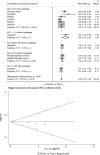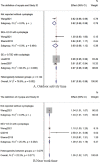Global risk factor analysis of myopia onset in children: A systematic review and meta-analysis
- PMID: 37729320
- PMCID: PMC10511087
- DOI: 10.1371/journal.pone.0291470
Global risk factor analysis of myopia onset in children: A systematic review and meta-analysis
Abstract
Introduction: This work aimed to comprehensively assess the risk factors affecting myopia in children to develop more effective prevention and treatment strategies. To this end, data from database were employed to assess the relationship between the incidence of myopia and its risk factors.
Methods: We searched eight databases online in June 2022. Cohort studies were included that measured the connection between risk factors and myopia. Eligibility was not restricted by language. The Newcastle-Ottawa Scale (NOS) was used to measure the risk of bias and conducted GRADE evaluation to determine the certainty of evidence. Potential risk factors with positive or negative results were seen. Inplasy Registration: https://inplasy.com/inplasy-2022-4-0109/.
Results: Evidence that risk factors for myopia are mixed, comprising both positive (20) and null (17) findings. In 19 cohort studies on 3578 children, girls were more likely to develop myopia (RR: 1.28 [1.22-1.35]). Myopia can occur at any age, from early childhood to late adulthood. Children whose parents had myopia were more likely to develop myopia. Longer outdoor activities time (RR: 0.97 [0.95-0.98]) and less near-work time (RR: 1.05 [1.02-1.07]) appeared to be significantly decrease the incidence of myopia. Children with lower SE, longer AL, a lower magnitude of positive relative accommodation, worse presenting visual acuity, deeper anterior chamber, and thinner crystalline lens may be related to myopia onset. The burden of myopia in underprivileged countries is higher than in developed countries (RR: 5.28 [2.06-13.48]). The quality of evidence for the evaluated factors was moderate to low or very low.
Conclusions: Genetic factors, environmental factors (such as excessive use of electronic products, and poor study habits) and lifestyle factors (such as lack of outdoor activities, poor nutrition, etc.) are the main risk factors for myopia in children. Myopia prevention strategies should be designed based on environmental factors, gender, parental myopia and eye indicators in order to explore a lifestyle that is more conducive to the eye health of children.
Copyright: © 2023 Yu et al. This is an open access article distributed under the terms of the Creative Commons Attribution License, which permits unrestricted use, distribution, and reproduction in any medium, provided the original author and source are credited.
Conflict of interest statement
The authors have declared that no competing interests exist.
Figures
References
Publication types
MeSH terms
LinkOut - more resources
Full Text Sources






